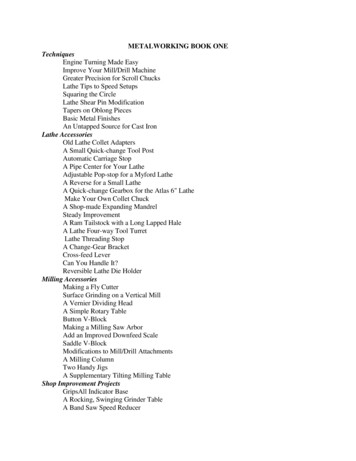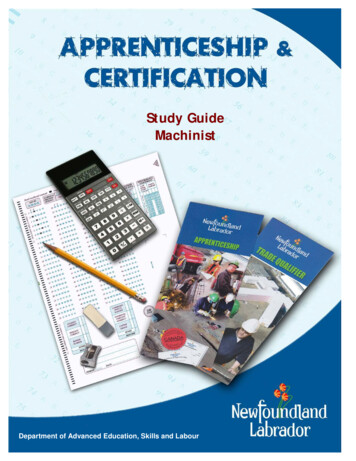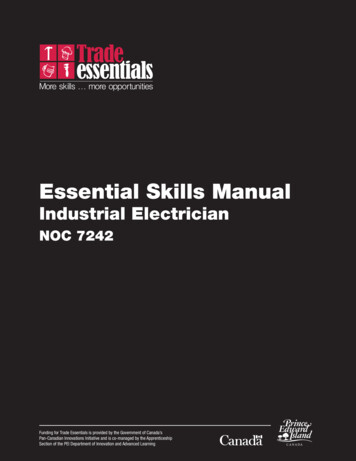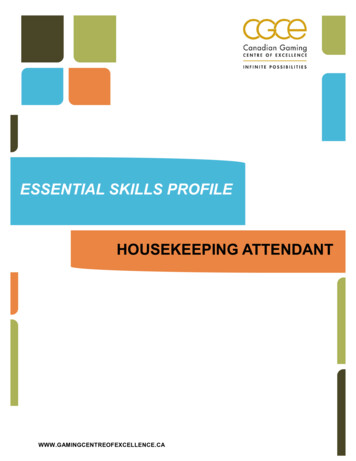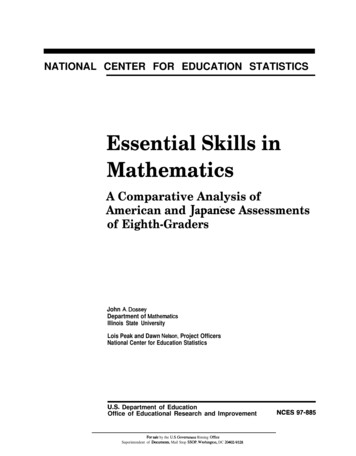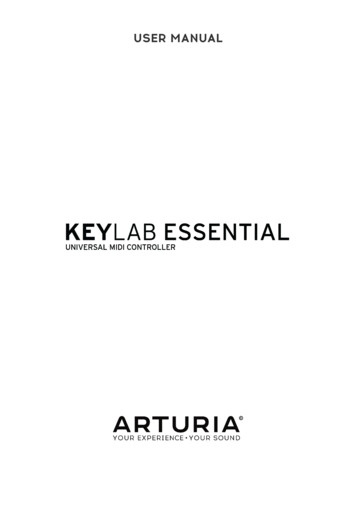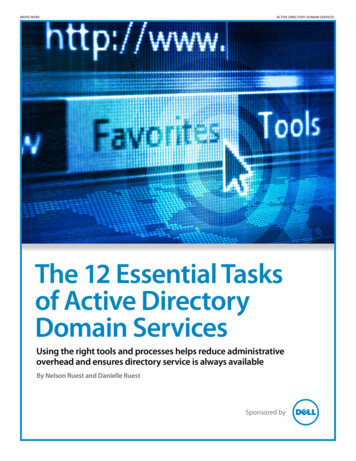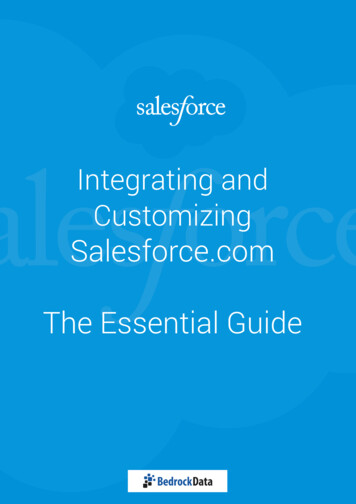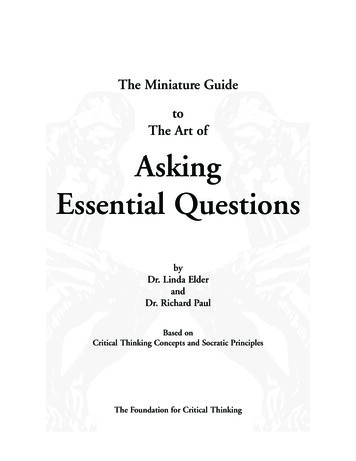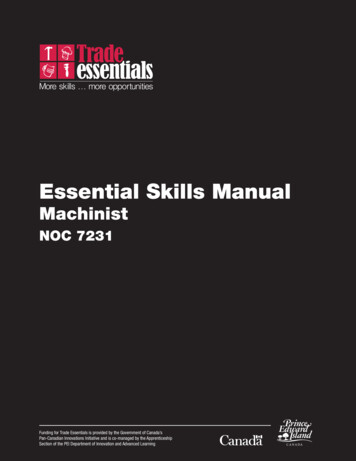
Transcription
Essential Skills ManualMachinistNOC 7231Funding for Trade Essentials is provided by the Government of Canada’sPan-Canadian Innovations Initiative and is co-managed by the ApprenticeshipSection of the PEI Department of Innovation and Advanced Learning
MACHINISTMANUAL CONTENTSIncluded in this Essential Skills Manual:PAGEEssential Skills Inventory Assessor’s Guide Essential Skills Inventory Technical Reading Document Use Numeracy Oral Communication Computer Use Writing 738434853646667Essential Skills Answer Key Technical Reading Document Use Numeracy Oral Communication Computer Use Writing 69768186100103105Essential Skills Curriculum Instructor Guide 107Curriculum Frameworks and Guidelines Technical Reading Document Use Numeracy Oral Communication Computer Use Writing Technical Skills Inventory 120121136154199210221231
ABOUT TRADE ESSENTIALSTrade Essentials is a research project funded under the Pan-CanadianInnovations Initiative, Human Resources and Skills Development Canada, inpartnership with the Apprenticeship Section of the PEI Department ofInnovation and Advanced Learning.The Trades Essentials program was designed to increase participation intrades by providing a well-defined pathway for each client to build on presentskills and access services necessary for success in his or her occupation.This new concept, focusing on essential skills and recognition of priorlearning (RPL), provides assessment, interventions and coordination ofservices for clients. This is the first project to provide a seamless learningpath to trades certification.To create this path, a number of educational tools were created and testedfor thirteen trades. These tools are available in both official languages for usein any jurisdiction.The Tools: Trade Specific Essential Skills Inventories (ESI)Through a dynamic assessment process using contextualized EssentialSkills assessments, clients can identify individual proficiency levels ofthe following Essential Skills: reading text, document use, numeracy,oral communication, writing and using computers.The Essential Skills Inventory and the Technical Skills Inventory assistthe client to develop a learning path which includes measurabletargets to reach his/her individual goals. Trade Specific Essential Skills CurriculumTrade specific curriculum frameworks have been created for each ofthe thirteen trades along with trades specific curriculum guidelines andsuggested resource materials. Technical Skills Inventories (TSI)Through a self assessment process, clients are able to identify theirindividual trade specific skills.The Thirteen Trades:Automotive Service Technician - Cabinet Maker – Carpenter - ConstructionElectrician – Cook - Industrial Electrician – Machinist - Metal Fabricator - OilBurner Mechanic - Plumber - Refrigeration and Air Conditioning Mechanic Steamfitter/Pipefitter - Welder
ACKNOWLEDGEMENTSMaterials from the Trade Essentials Manuals may be reproduced for individualeducational purposes only. No part of this material may be reproduced orused for any commercial purpose or sold by any person other than theowner.This project is the result of the collaboration of the following dedicated adulteducational consultants in Prince Edward ayDempsey.Our sincere thanks to the Trade Essentials Advisory Committee for theirsuggestions, input and ongoing support.We also recognize the valuable contribution made by the apprentices andchallengers who volunteered to participate in this research project. It is oursincere hope that they have gained as much from their participation as wehave. We also hope that their contributions will assist many moretradespeople to reach their goals.We are grateful to the assessors, tutors and classroom instructors whopatiently piloted our materials and who gave back invaluable insights andadvice.All Trade Essentials materials have been validated by teams of tradespeoplewho hold Certificates of Qualification, Red Seal Endorsement. We gratefullyacknowledge the crucial contribution made by the following team members:RGlenn Ellsworth (Automotive Service Technician)Cecil Banks (Automotive Service Technician)Scott Bagnall (Automotive Service Technician)Darcy MacKenzie (Automotive Service Technician)Elmer MacDougall (Cabinet Maker)Graham Hicken (Cabinet Maker)Gerard Lund (Carpenter)Leo MacDonald (Carpenter)yan Rogerson (Carpenter)Darren Richards (Construction Electrician)Mark Seaman (Construction Electrician)
Ken Zakem (Cook)Rod Lukeman (Cook)Barry Strongman (Industrial Electrician)Gregg Francis (Industrial Electrician)Jake Shaw (Machinist)Sue LeFort (Machinist)John Hebert (Metal Fabricator / Welder)Joe Johnson (Metal Fabricator)Jim Arsenault (Metal Fabricator)Kent Mitchell (Oil Burner Mechanic / Steamfitter-Pipefitter)Rod Arsenault (Oil Burner Mechanic / Refrigeration and AirConditioning Mechanic)KentMitchell (Plumber)Scott Carter (Plumber)Charlie Redmond (Refrigeration and Air Conditioning Mechanic)Scott Lacey (Steamfitter-Pipefitter)Vincent Jenkins (Welder)Thanks to the Apprenticeship Section of the PEI Department of Innovationand Advanced Learning and to the Government of Canada’s Pan-CanadianInnovation Initiative for financial assistance and for continuing support totrades and apprentices in Canada.
Essential Skills Inventory Assessor’s Guide
ESSENTIAL SKILLS INVENTORYASSESSOR’S GUIDETABLE OF CONTENTS1SECTION 1 . 101.12Introduction. 10SECTION 2 . 102.1Interactive Assessment . 102.2Adult Education . 112.2.1Principles of Adult Education. 112.2.2Characteristics of Adult Learners . 123SECTION 3 . 143.1The Essential Skills Inventory . 143.1.1Process . 143.1.2Essential Skills Profiles . 143.1.3Preparation . 153.1.4Sections of the Inventory. 174SECTION 4 . 214.15Essential Skills Inventory Records . 21SECTION 5 . 215.1Essential Skills Post-Inventory . 215.1.1Post-Inventory Directions. 215.1.2Post-Inventory Reporting Form . 22APPENDIX A - FORMSAPPENDIX B – EXTRA INFORMATIONPage 7
ESSENTIAL SKILLS INVENTORYASSESSOR’S GUIDEGLOSSARYThe definitions are intended as a guide for the language used in the EssentialSkills Inventories.ABEAdult Basic EducationApprenticeFor the purpose of this Guide, apprentice is an inclusiveterm that refers to anyone working in a trade except thosealready certified.Authentic workplacedocumentsActual documents obtained from an employer that may beused as teaching tools. An example document is a MaterialSafety Data Sheet (MSDS).Block Release TrainingA period of in-school training for apprentices. It may alsobe referred to as Period Training or a Level.Dynamic (interactive)AssessmentA flexible, holistic, context-sensitive approach used toevaluate learning.Essential SkillsThe set of nine skills defined by Human Resources and SkillsDevelopment Canada as being common to all occupations.The skills are: reading text (technical language), documentuse, numeracy (math), oral communication, writing,computer use, thinking skills, continuous learning andworking with others.Essential Skills ProfileA document that describes how each Essential Skill is usedby an occupational group.GEDGeneral Education Diploma; a Grade 12 equivalency foradults.Grade 12A diploma issued by a provincial or territorial governmentthat recognizes completion of High School. It is a challengeto use this as a common credential, since there are severaldifferent Grade 12 diplomas.Page 8
ESSENTIAL SKILLS INVENTORYASSESSOR’S GUIDEInterventionFor the purpose of this Guide, intervention refers to a tradespecific Essential Skills program delivered to either a groupor an individual.JourneypersonA person who holds a Certificate of Qualification in adesignated trade. A certified journeyperson is allowed totrain and mentor apprentices.Red SealA seal of endorsement applied to a Certification ofQualification for a trade. It allows for mobility amongprovinces and territories. A certified journeyperson isallowed to train and mentor apprentices.Trade EssentialsA three-year research project to develop Essential Skills andPrior Learning assessments and curricula specific to 13trades and to pilot the materials with six of those trades.The 13 trades included in this project were: AutomotiveService Technician, Carpenter, Cabinetmaker, Cook,Construction Electrician, Industrial Electrician, Machinist,Metal Fabricator, Oil Burner Mechanic, Plumber,Refrigeration and Air Conditioning Mechanic,Steamfitter/Pipefitter and Welder. Materials were pilotedwith Carpenters, Steamfitter/Pipefitters, Welders,Automotive Service Technicians, Plumbers and Cooks.Page 9
ESSENTIAL SKILLS INVENTORYASSESSOR’S GUIDE1 SECTION 1The Essential SkillsInventories include: reading text document use numeracy oral communication computer use writing1.1 IntroductionThe Essential Skills Inventories were developed during athree-year Trade Essentials project whose mandate was todevelop Essential Skills assessments and curricula for 13trades. These materials provide an opportunity fortradespeople to identify and update the Essential Skillsrequired for their respective trades as an important steptowards successful trade certification. The Essential SkillsInventory is a tool used to identify both strengths andweaknesses in trade-specific Essential Skills profiles.2 SECTION 2Essential Skills Inventories:Automotive Cook6242Construction Electrician7241Industrial Electrician7242Machinist7231Metal Fabricator7263Oil Burner Mechanic7331Plumber7251Refrigeration and Air Welder72652.1 Interactive AssessmentAdult learners have different needs than “traditional”students so strategies must be developed to engage,motivate and build their confidence.The Essential Skills Inventories use an innovative, interactive(dynamic) approach to assessment that is both clientcentred and asset-based. An asset-based approachcompares the apprentices’ present Essential Skills to theskills needed for their trade, connecting what they alreadyknow with what they need to learn.The Inventory is a process more than a product and requiresskilled and experienced assessors to establish anatmosphere where apprentices are comfortable enough tothink about and explore their learning in an Essential Skillscontext. Assessors need the “inner technology” to besensitive to the needs of the apprentice and to knowwhen to stop an Essential Skills Inventory if theapprentice is struggling. The interactive assessmentexplores not only what the apprentice knows and can do, butalso, gives an awareness of how the apprentice learns.This type of assessment can be used in a pre- and postformat but cannot be referred to normative tables forinterpretation. It is designed as a starting point forinstruction in Essential Skills for the trades.Page 10
ESSENTIAL SKILLS INVENTORYASSESSOR’S GUIDEBy using the trade-specific Essential Skills Inventory you canhelp an apprentice identify those skills to be updated bybuilding upon the skills he/she already has. This processprovides immediate, individual feedback to the learner. Thisis an assessment used for learning, not of learning.We need assessment andtraining so the workforcehas the requiredEssential Skills to adaptto changing demands.Motivation is fundamental to change and this process helpsan apprentice become motivated, engaged and confident inlearning. Confidence can never be disconnected from skills.However, the apprentice does need to have a readiness,willingness and an ability to learn in order to be successful.In addition, many adults fear returning to a structuredlearning environment after a lengthy absence. It is verydifficult to discover the learning needs of adults without thecreation of a “safe environment”. This is even more evidentwith those who have the greatest learning needs.Why do apprentices need to go through this process?At present, there is neither a process nor a place for thosewho are already working in a trade to update their traderelated Essential Skills other than completing Block training.Awareness of the trade-specific Essential Skills and theknowledge of the scope of a trade is a starting point on thepath to certification. Individual assessmen
Jake Shaw (Machinist) Sue LeFort (Machinist) John Hebert (Metal Fabricator / Welder) Joe Johnson (Metal Fabricator) Jim Arsenault (Metal Fabricator) Kent Mitchell (Oil Burner Mechanic / Steamfitter-Pipefitter) Rod Arsenault (Oil Burner Mechanic / Refrigeration and Air Conditioning Mechanic) Kent Mitchell (Plumber) Scott Carter (Plumber)File Size: 2MBPage Count: 266Explore further(PDF) Machinery's Handbook 28th Edtion Large Print .www.academia.eduHome Machine Shop Projects - That Lazy Machinistwww.thatlazymachinist.comCool projects made on Manually . - Practical Machinistwww.practicalmachinist.comRecommended to you based on what's popular Feedback
